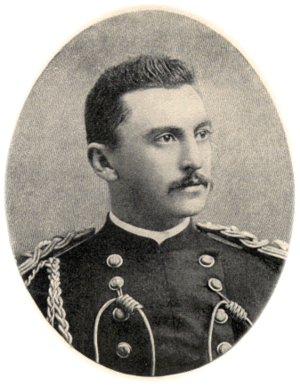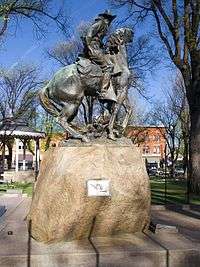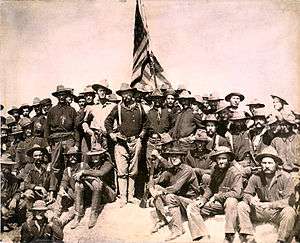Buckey O'Neill
| William Owen O'Neill | |
|---|---|
 | |
| Nickname(s) | Buckey |
| Born |
February 2, 1860 St. Louis, Missouri |
| Died |
July 1, 1898 (aged 38) San Juan Hill, Cuba |
| Buried at | Arlington National Cemetery |
| Allegiance |
|
| Service/branch |
|
| Years of service | 1898 |
| Rank | Captain |
| Unit | 1st Volunteer Cavalry Regiment |
| Battles/wars | |
William Owen "Buckey" O'Neill (February 2, 1860 – July 1, 1898) was a sheriff, newspaper editor, miner, politician, Georgist, gambler and lawyer, mainly in Arizona. His nickname came from his tendency to "buck the tiger" (play contrary to the odds) at faro or other card games.[1] He later became a captain in Theodore Roosevelt's Rough Riders, and died in battle.[2]
Early life
O'Neill was born on February 2, 1860, either in St. Louis, Missouri, or Washington, D.C., although he sometimes listed Ireland as his birthplace. This last is doubtful, since his parents had been in the United States since the 1850's. During the Civil War, his father, John, served as a captain in the 116th Pennsylvania Volunteers of the Irish Brigade, and was severely wounded at the Battle of Fredericksburg.
Tombstone
In 1879, O'Neill left home, heading for Arizona Territory. In 1880, he settled in Tombstone, Arizona. During this time the Earp Brothers, the city policemen, and the Clanton-McLaury Gang, a group of rustlers and murderers, were at war with each other. O'Neill joined the Tombstone Epitaph; since it was a pro-Earp newspaper, he frequently talked with, and became a casual acquaintance of, the Earps. On October 26, 1881 the war escalated with the Gunfight at the O. K. Corral. O'Neill may have been the man to report on the scene. He left Tombstone shortly after, heading for Prescott, Arizona.
Prescott
O'Neill arrived in Prescott in the spring of 1882. There he rapidly progressed in his journalistic career. Starting as a court reporter, he soon founded his own newspaper, Hoof and Horn, a paper for the livestock industry.
He became captain of the Prescott Grays in 1886, the local unit of the Arizona Militia.[3] On February 5, 1886, Dennis Dilda, a convicted murderer, was hanged. O'Neill and the Prescott Grays stood honor guard for the event. When the trap dropped, O'Neill fainted, which caused him severe embarrassment. He later wrote a story called "The Horse of the Hash-Knife Brand." In it, a member of a posse admits to nearly fainting at the hanging of a horse thief.
In April 27, 1886, he married Pauline Schindler.[4] They had a son, but he died shortly after being born premature.
In 1888, while serving as Yavapai County, Arizona judge, he was elected county sheriff, running on the Republican ticket.
On March 20, 1889, four masked men robbed the Atlantic and Pacific Railroad passenger train in Diablo Canyon. A four-man posse, made up of O'Neill, Jim Black, Carl Holton, and Ed St. Clair, was soon formed and they took off after robbers. On March 21, O'Neill and his posse caught up with the robbers. After exchanging rifle shots, the posse captured the four men. During the fight, no men were injured, but O'Neill's horse was killed.
The four men were William Sterin, John Halford, Daniel Harvick, and J. J. Smith. All four were sent to the Yuma Territorial Prison, but were pardoned eight years later. There is unfounded speculation that, in 1898, William Sterin enlisted under a false name in the Rough Riders, and was killed in action on San Juan Hill. The character of Henry Nash is incorrectly portrayed as Sterin in the TNT made-for-TV movie "Rough Riders". The real Henry Nash was an Arizona school teacher who also served in Roosevelt's Rough Riders, and was a friend of O'Neill up until his death.
After his term was up, O'Neill was elected unanimously Mayor of Prescott.
In 1894 and 1896 he ran for Delegate to the United States House of Representatives from Arizona Territory, running on the Populist Party ticket.
One of his best friends was Tom Horn.
In 1897, after years of speculating on mines, he sold a group of claims near the Grand Canyon to Chicago backers, who also proposed building a railroad from Williams to the mines and the south rim. He became a director of the development companies, and soon began railroad surveys, mine developments, and building a smelter. He also used profits to begin building rental buildings -- he was headed for financial independence.[5]
Rough Riders

In 1898, war broke out between the United States and Spain. O'Neill joined the Rough Riders and became Captain of Troop A. First Lieutenant Frank Frantz served as O'Neil's Deputy Commander. Along with Alexander Brodie and James McClintock, he tried to make an entire regiment made up of Arizona Cowboys. Eventually though, only three troops were authorized.
The Rough Riders landed at Daiquirí on June 22, 1898. Two Buffalo Soldiers, of the 10th Cavalry fell overboard. Upon seeing this, O'Neill jumped into the water in full uniform and sabre. He searched for the men for two minutes, before having to come up for breath.
On June 25, 1898, the Rough Riders saw their first action. O'Neill led his men at the front of the line in the Battle of Las Guasimas, capturing the Spanish flank. During the action he saw several men, whom he believed were Spaniards, across the road from him, and shouted "Hostiles on our right, fire at will!" He learned after the firing ceased that the men he exchanged shots with were Cuban rebels.
Death

On July 1, 1898, at about 10am, the Rough Riders and the 10th Cavalry were stationed below Kettle Hill. The Spaniards, who were on top of the hill, poured machine gun and Mauser fire down on the Americans. Buckey O'Neill was killed in action.
Theodore Roosevelt, commander of the Rough Riders, wrote about the death of O'Neill:
The most serious loss that I and the regiment could have suffered befell just before we charged. O'Neill was strolling up and down in front of his men, smoking his cigarette, for he was inveterately addicted to the habit. He had a theory that an officer ought never to take cover—a theory which was, of course, wrong, though in a volunteer organization the officers should certainly expose themselves very fully, simply for the effect on the men; our regimental toast on the transport running, 'The officers; may the war last until each is killed, wounded, or promoted.' As O'Neill moved to and fro, his men begged him to lie down, and one of the sergeants said, 'Captain, a bullet is sure to hit you.' O'Neill took his cigarette out of his mouth, and blowing out a cloud of smoke laughed and said, 'Sergeant, the Spanish bullet isn't made that will kill me.' A little later he discussed for a moment with one of the regular officers the direction from which the Spanish fire was coming. As he turned on his heel a bullet struck him in the mouth and came out at the back of his head; so that even before he fell his wild and gallant soul had gone out into the darkness.[6]
Before the fighting was over, O'Neill's men had buried him on the slope of San Juan Hill. After the war, his family and friends enlisted help from the War Department to find and recover his body. After six men failed to find the site, the War Department sent Henry Alfred Brown, the Rough Riders' Chaplain, to find him. Despite it being eight months since O'Neill's death, Chaplain Brown located the site within two hours after arriving in Santiago. The well preserved body was exhumed, placed in a coffin, and returned to the United States on the Army transport Crook.[7] He was reinterred in Arlington National Cemetery, Section 1, Site 294.[8]
On July 3, 1907, a monument by sculptor Solon Borglum was dedicated to O'Neill and the other Rough Riders in their memory in Prescott, Arizona. Seven thousand people gathered to witness the unveiling.
Movies
Bucky (sic) O'Neill is a main character in the TNT movie Rough Riders, portrayed by Sam Elliott[9]
See also
- Buckey O'Neill Cabin in Grand Canyon National Park, built by O'Neill in 1890 and listed on the National Register of Historic Places
References
- ↑ Gorby, Richard (February 6, 2000). "Buckey O'Neill's Advice for Horse Owners". Sharlot Hall Museum.
- ↑ Smithsonian National Postal Museum: Rough Riders Issue
- ↑ Arizona Military History by Chaplain Thomas E. Troxell Archived January 20, 2007, at the Wayback Machine.
- ↑ "Got It Bad". The Daily Tombstone. Tombstone, Arizona. 7 May 1886. p. 3.
- ↑ David F. Myrick, Railroads of Arizona, Volume 6, Jerome and the Northern Roads
- ↑ O'Toole III, G. J. A. (1984). The Spanish War: An American Epic 1898. W. W. Norton & Company. p. 314. ISBN 0-393-30304-7.
- ↑ "Found "Bucky" O'Neill". New-York Tribune. New York, NY. 23 April 1899. p. 14.
- ↑ "William Owen "Bucky" O'Neill", Arlington National Cemetery
- ↑ Rough Riders (1997) (TV) at the Internet Movie Database
Sources
- "Rough Riders". Smithsonian National Postal Museum. Retrieved Jan 11, 2014.
External links
- Arlington National Cemetery Website page on O'Neill
- Spanish–American War Centennial Website page on O'Neill
- Wyoming Tales and Trails on the Rough Riders
- Photograph of Buckey O'Neill statue
- Grave of Buckey O'Neill at Find a Grave
